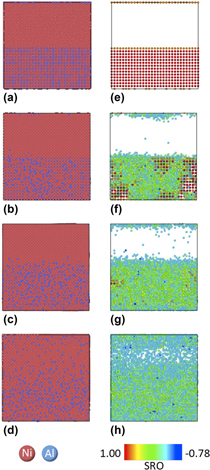Crossref Citations
This article has been cited by the following publications. This list is generated based on data provided by
Crossref.
Martínez, Enrique
Soisson, Frédéric
Caro, Alfredo
and
Uberuaga, Blas P.
2016.
Atomistic modeling of the reordering process of γ′ disordered particles in Ni-Al alloys.
Journal of Nuclear Materials,
Vol. 478,
Issue. ,
p.
207.
Huang, Hai
Tang, Xiaobin
Chen, Feida
Liu, Jian
and
Chen, Da
2017.
Role of graphene layers on the radiation resistance of copper–graphene nanocomposite: Inhibiting the expansion of thermal spike.
Journal of Nuclear Materials,
Vol. 493,
Issue. ,
p.
322.
Voskoboinikov, Roman
2019.
MD simulations of primary damage formation in L12 Ni3Al intermetallics.
Journal of Nuclear Materials,
Vol. 522,
Issue. ,
p.
123.
Voskoboinikov, Roman
2019.
A contribution of L10 ordered crystal structure to the high radiation tolerance of γ-TiAl intermetallics.
Nuclear Instruments and Methods in Physics Research Section B: Beam Interactions with Materials and Atoms,
Vol. 460,
Issue. ,
p.
92.
Sun, Cheng
Maloy, Stuart A.
Baldwin, Kevin
Wang, Yongqiang
and
Valdez, James A.
2020.
Phase Stability of Ni/Ni3Al Multilayers Under Thermal Annealing and Irradiation.
JOM,
Vol. 72,
Issue. 11,
p.
3995.
Saidi, Peyman
Changizian, Pooyan
Nicholson, Eric
Zhang, He Ken
Luo, Yu
Yao, Zhongwen
Singh, Chandra Veer
Daymond, Mark R.
and
Béland, Laurent Karim
2020.
Effect of He on the Order-Disorder Transition in
Ni3Al
under Irradiation.
Physical Review Letters,
Vol. 124,
Issue. 7,
Yeli, Guma
Chen, Da
Yabuuchi, Kiyohiro
Kimura, Akihiko
Liu, Shaofei
Lin, Weitong
Zhao, Yilu
Zhao, Shijun
and
Kai, Ji-Jung
2020.
The stability of γ′ precipitates in a multi-component FeCoNiCrTi0.2 alloy under elevated-temperature irradiation.
Journal of Nuclear Materials,
Vol. 540,
Issue. ,
p.
152364.
Tawfeeq, Maisaa N.
and
Klassen, Robert J.
2021.
Ni+ and He+ Implantation Effects on the Hardness and Microstructure of Heat-Treated X750 Superalloy.
Journal of Nuclear Engineering and Radiation Science,
Vol. 7,
Issue. 1,
Ferasat, Keyvan
Swinburne, Thomas D.
Saidi, Peyman
Daymond, Mark R.
Yao, Zhongwen
and
Béland, Laurent Karim
2021.
Interstitialcy-based reordering kinetics of Ni3Al precipitates in irradiated Ni-based super alloys.
Materialia,
Vol. 19,
Issue. ,
p.
101180.
Zhao, Shijun
Chen, Da
Yeli, Guma
and
Kai, J.J.
2021.
Atomistic insight into the effects of order, disorder and their interface on defect evolution.
Journal of Alloys and Compounds,
Vol. 859,
Issue. ,
p.
157770.
Sun, Cheng
Bachhav, Mukesh N.
Wang, Yongqiang
Li, Meimei
and
Maloy, Stuart A.
2021.
Helium-bubble-enhanced disordering of intermetallic phase under irradiation.
Materials Characterization,
Vol. 176,
Issue. ,
p.
111094.
Chen, Youxing
Chen, Di
Weaver, Jordan
Gigax, Jonathan
Wang, Yongqiang
Mara, Nathan A.
Fensin, Saryu
Maloy, Stuart A.
Misra, Amit
and
Li, Nan
2023.
Heavy ion irradiation effects on CrFeMnNi and AlCrFeMnNi high entropy alloys.
Journal of Nuclear Materials,
Vol. 574,
Issue. ,
p.
154163.
Hayakawa, Sho
and
Xu, Haixuan
2024.
Development of an interatomic potential for L12 precipitates in Fe–Ni–Al alloys.
Computational Materials Science,
Vol. 232,
Issue. ,
p.
112614.



